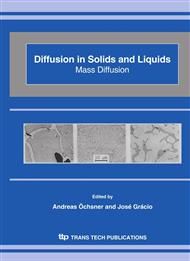p.113
p.118
p.124
p.130
p.137
p.146
p.152
p.158
p.164
Anelastic Relaxation due to Interstitial Solutes Diffusion in Nb and Nb-1 wt% Zr
Abstract:
Metals and alloys containing solute atoms dissolved interstitially often show anelastic behavior due to a process know as stress-induced ordering. The application of mechanical spectroscopy measurements to diffusion studies in body-centered cubic metals has been extensively used in the last decades. However the kind of preferential occupation of interstitial solutes in bodycentered cubic metals is still controversial. The anelastic properties of the Nb and Nb-1 wt% Zr polycrystalline alloys were determined by internal friction and oscillation frequency measurements using a torsion pendulum inverted performed between 300K and 650K, operating in a frequency oscillation in the hertz bandwidth. The interstitial diffusion coefficients of oxygen and nitrogen in Nb and Nb-1 wt% Zr samples were determined at two distinct conditions: (a) for low concentration of oxygen and (b) for high concentration of oxygen.
Info:
Periodical:
Pages:
137-145
Citation:
Online since:
October 2006
Keywords:
Price:
Сopyright:
© 2006 Trans Tech Publications Ltd. All Rights Reserved
Share:
Citation:


